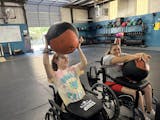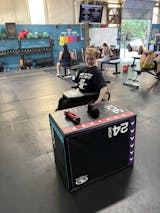https://www.shape.com/fitness/motivation/maggie-rath-bilateral-amputee
We had the pleasure of meeting Maggie at Wodapalooza in 2018 I believe. What a competitor.
From the Shape Magazine Article:
Maggie Rath first suspected something was up with her health back in August 2016. Her left pinky had suddenly become stiff, achy, and peculiarly curved, she tells Shape.And when the bizarre situation didn't clear up, her primary care doctor and a rheumatologist chalked it up to arthritis or carpal tunnel syndrome.
But the prescriptions she began taking for those conditionsdidn't do the trick. In fact, over the next few weeks, "my other fingers began to bend in these abnormal, unrealistic, alien-like ways," says Rath, then 29 years old. "I was living with just being uncomfortable all the time, but then it got to the point where it was just painful." The mysterious symptoms then spread to her toes and calves, which were so tight, that she couldn't place her heels on the floor, she recalls.
By early September, Rath, an avid CrossFit athlete, had seen neurologists who diagnosed her with a hodgepodge of disorders, including multiple sclerosis, ALS, and Parkinson's disease, among others. Over the next eight months, she received intravenous immunoglobulin infusions (in which antibodies from healthy donors are given via IV to prevent your immune system from attacking your body), four rounds of chemotherapy, and countless medications.
Still, nothing was working. "I just remember being really frustrated that I had been to half a dozen doctors and nobody could figure me out," says Rath. "Once test results came back or the doctors heard my story or saw it, then they would essentially fire me and pass me along to somebody else. It was like I was a flyer being passed [around]."
To this day, despite those initial diagnoses, Rath's doctors still haven't pinpointed the exact cause of her symptoms.
Throughout that period, Rath's illness progressed to her legs, and her lower half morphed into what she describes as a mermaid-like tail: Her feet bent in toward one another, and her toes crinkled up and curled under her feet. It was on April 8, 2017, just nine months after her first symptom showed up, that she took what would be her final steps using her own two feet — and on her wedding day. "I walked down the aisle, and woke up the next day and could no longer walk," she says.
This rapid degeneration of her legs took a mental toll, says Rath. "I essentially lost all [sense of] purpose," she adds. She ruminated on why this inexplicable illness was happening to her, coming up with countless possible reasons to try to make sense of her situation. No matter which conclusion she came to, though, it usually made her angry at the world around her, says Rath. "Then one day, I just kind of came to grips with it and said to myself, 'You're not meant to be figured out. You just have to deal with it,'" she says.
The following year, in 2018, Rath says she decided to live her life as is (meaning, without any treatments) and wanted to ease back into CrossFit. She saw first-hand how other folks with disabilities were able to take charge of their lives through the sport, she explains. So, rather than dwell on the condition that left her in a wheelchair,Rath reimmersed herself in the activity she loved, she says. Over the next few years, she trained three times a week, learning how to do exercises that were traditionally done standing while seated and how to lift a barbell using wrist straps and hooks. She even competed in Wodapalooza, an annual CrossFit competition in Miami. "I was like, 'I don't need to feel sorry for myself anymore. Yeah, life sucks, but now it's time to just get over it and figure out how to have the best quality of life with whatever I was given,'" she adds.
A triumphant return to a physically exhaustingsport by anyone's standard seems like the perfect happy ending, but Rath's story was far from over. By a stroke of luck — and a profile detailing her health journey in Shape — in 2019, a researcher at MIT discovered Rath and suggested she watch a TED Talk by Hugh Herr, a man who lost both of his legs in a climbing accident and now uses and creates bionic limbs that mimic the function of natural limbs at MIT's Yang Center for Bionics. Coincidentally, Rath's uncle, a retired physician, sent her the exact video the same night. "I was just reading about this guy and seeing that he's crushing it, and I was like, 'I need to learn how to crush it too,'" she says.
Rath immediately began digging into research on amputations below and above the knees and Googling bionic prosthetic limbs, just like Herr's. What she found ultimately led her to a decision she says she had been considering for years: "Chopping" her legs off, as Rath puts it. "I had no problem cutting them off. They'd never serve me ever again, and [doctors would]never give me some magic pill that would make me stand up and walk again…[So] I started to really think, 'What if I went through this entire process, for real?'"
I had no problem cutting them off. They'd never serve me ever again, and they'd never give me some magic pill that would make me stand up and walk again.
MAGGIE RATH ON DECIDING TO RECEIVE A BILATERAL LEG AMPUTATION
A week or two later, Rath reached out to other experts at MIT and Brigham and Women's Hospital who had been doing studies on a new procedure known as the Ewing Amputation. This type of amputation preserves the normal signaling between the muscles and brain, so patients will feel like they're controlling their actual limb, not a prosthesis, according to information published by the hospital. Much to her surprise, she received a response in just two hours. Over the next few months, Rath spoke with the research team via Zoom to discuss her story and goal of being wheelchair-free, and she met various medical professionals in person to ensure amputation was the last — but best — resort for her condition, she explains.
By November 2021, Rath had surgery for a bilateral leg amputation scheduled for the following March. She spent the next five months doing CrossFit six days a week to ensure her body was as strong as possible for the procedure and recovery period. And she sought guidance on how to prepare for and what to expect from a fellow bilateral amputee, who had just undergone the Erwing procedure two years prior, says Rath.
Still, Rath knew there would be risks associated with her procedure. While amputating her legs below the knee could eliminate the pain she felt in her feet, shins, calves, and Achilles tendon, there was also a good chance it could exacerbate it, causing the still unknown condition to "attack" other muscle groups, Rath recalls her doctor warning her. But with dreams of "being vertical" again, Rath decided to take the chance and went into her surgery with "zero nerves," she says. After the nine-hour operation, Rath became the first female in this particular research group to electively amputate both legs at the same time, she says.:max_bytes(150000):strip_icc():format(webp)/Maggie-Rath-After-Amputation-2000-19a0282b0c14475fad3e6a79b87f5615.jpg)
Within a week of her life-changing surgery, Rath was transferred from her hospital room to a rehab facility in Boston. There, she began physical therapy while wearing immobilizers, a special type of leg brace designed to keep residual limbs and knees protected and properly positioned while healing, she says. Ironically, April 8 once again proved to be a key date in her life. "When my husband and I got married, it was the last day I walked," she says. "And now, my fifth-year anniversary is the start of the journey for the day I first walk again."
Rath spent just two weeks at the rehab facility before being transferred home to her apartment across the street, which she credits to all her CrossFit workouts and a positive mindset. By the end of May, on her 35th birthday, Rath received her first pair of prosthetic legs. "It was the first time I stood up in five years," she says. "It was a complete feeling of liberation. I was the happiest person."
Nowadays, Rath is doing physical therapy for two and half hours a day, five days a week back home in Virginia, but she doesn't mind the workload. Thanks to all these sessions, she doesn't need to spend extra time loading her wheelchair into the car or stress about it running out of battery if she wants to go out shopping, for instance; she can just slip on her legs and walk out the door without a worry, she says. (FTR, Rath doesn't describe herself as a speed walker just yet, but she's not a "baby giraffe falling over," either.)
This upcoming October, Rath will make her way back to MIT to test out her first bioengineered legs, which will have separate toes that she should be able to control due to the innovative surgery, she explains. "Essentially I can still feel my toes, and if you told me to wriggle my big toe right now, I can do that," she adds. "[With the prostheses,] it will be like I have five real toes. If I wanted to dance and be a ballerina, I will be able to — I could go and be in pointe shoes."
Regardless of the type of prostheses she's using, Rath is hell-bent on doing everything she can with her new limbs, from participating in CrossFit once again to trying new adaptive sports such as snowboarding or swimming. And one day, she hopes to take whatever skills she fosters to compete on the world stage, meeting some incredible athletes along the way., she says. "I never thought I would say this, but the disabled community is my community — that's who I am," says Rath. "I think it would be stupid for me to not take advantage of meeting people who have similar ways of thinking and adapting." Next up: Surfer Bethany Hamilton On the Importance of Creating Inclusive Environments for Adaptive Athletes


:max_bytes(150000):strip_icc():format(webp)/megan-falk-0f5804c67bbe40e3aed097f29302588f.jpg)

